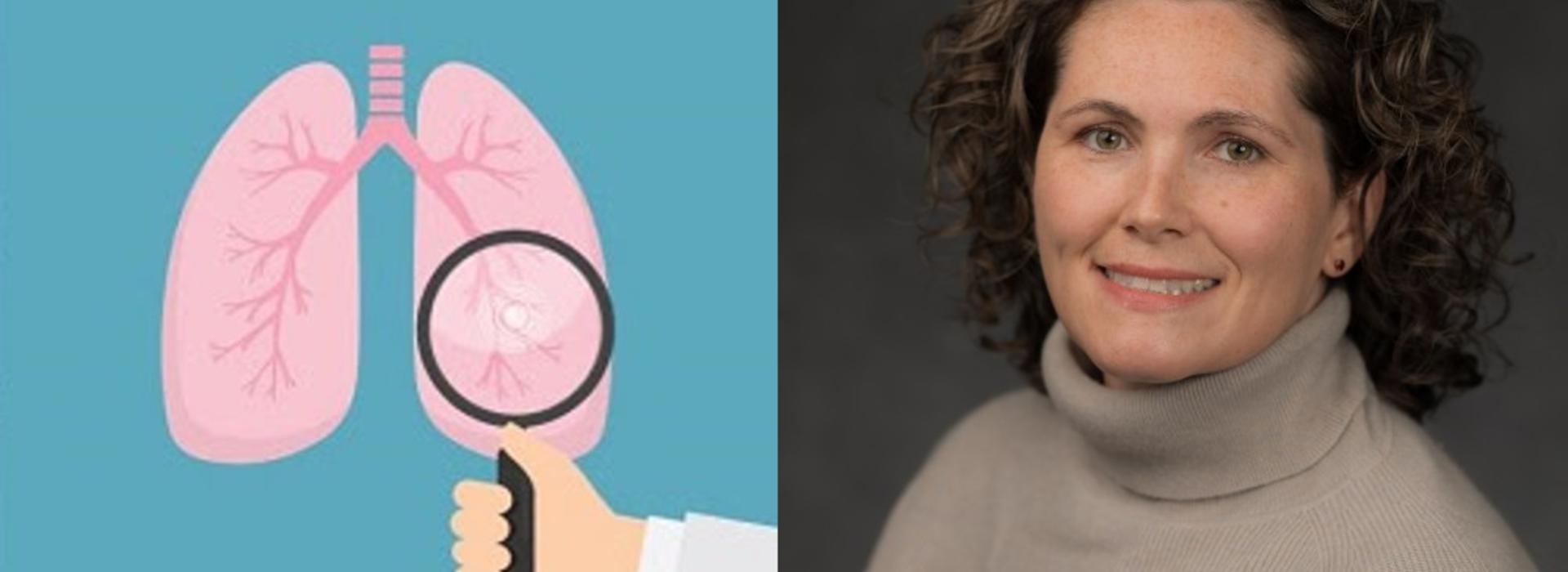
Talking lung cancer awareness with U of M
MINNEAPOLIS/ST. PAUL (11/16/2022) — November is National Lung Cancer Awareness Month. According to the Centers for Disease Control and Prevention, lung cancer is the leading cause of cancer death, accounting for 23% of all cancer deaths.
Abbie Begnaud, MD, with the University of Minnesota Medical School, M Health Fairview and Masonic Cancer Center, answers questions on the symptoms, risk factors and treatment for lung cancer.
Q: Who is at risk of developing lung cancer?
Dr. Begnaud: Anyone can get lung cancer. Long-term exposure to environmental agents like cigarette smoke, smog or radon can put people at higher risk. Substances found at some workplaces can also increase risk such as asbestos, arsenic, diesel exhaust and some forms of silica and chromium. For many of these substances, the risk of getting lung cancer is even higher for those who smoke cigarettes. Radon is a naturally occurring gas that you can’t smell, see or taste. It is common, especially here in Minnesota, and can enter your home through the soil and remain trapped inside the home. The average radon level in Minnesota is more than three times higher than the average U.S. radon level. The only way to know if this is happening is to test your home with kits available commercially or through the Minnesota Department of Health. People who have an immediate family member who has lung cancer are also at a higher risk of developing lung cancer. If you have ever been a cigarette smoker and would like to know your personal risk for cancer, you can calculate it here.
Q: What are the symptoms of lung cancer?
Dr. Begnaud: Initially, there are none. Lung cancer can develop and grow in the lungs for some time before symptoms occur. By the time most people with lung cancer have any symptoms, the disease is usually advanced. People with lung cancer might experience coughing, chest discomfort, difficulty breathing or weight loss. Because there are no symptoms of early lung cancer, people who have been cigarette smokers for years might benefit from screening for lung cancer. Lung cancer screening is a low-dose CT (or CAT) scan to look at the lung tissue. The test takes just a few minutes and requires no fasting, no prep and no IV. It’s the easiest of all currently available screening tests.
Q: What are the treatment options for lung cancer?
Dr. Begnaud: Broadly, treatment includes surgery to remove the cancer, radiation treatment and systemic therapy or medications. The best chance for cure is with surgical removal, if possible. Recent advances in lung cancer treatment have revolutionized the field. Some lung cancers will have targets for treatment, mutations that contributed to the cancer and can be directly blocked to shrink or destroy the cancer. These newer targeted therapies are easier to take and more effective than traditional chemotherapy. In addition, immunotherapy — a new class of treatment with drugs approved since 2015 — allows the body’s immune system to recognize and fight cancer cells. More than 20 new drugs have been approved in the last two years. We have more promising treatments for lung cancer today than we ever have.
Q: How can early screening impact lung cancer outcomes?
Dr. Begnaud: The impact of early screening is dramatic. Lung cancer that is diagnosed very early at stage 1 may have an 80 to 90% chance of cure, which is why screening is so important. Even more advanced lung cancer outcomes are improving with new treatments.
Q: What are you doing to advance lung cancer research?
Dr. Begnaud: My work focuses on improving access to lung cancer screening, which is a relatively new preventive care service. We estimate that only 8% of people who are eligible for lung cancer screening have been screened. Meanwhile, other cancer screening services like mammography see more than 70% of eligible people get screened. In addition, lung cancer is a disease that disproportionately affects some groups in Minnesota such as African Americans and American Indians/Alaska Natives. I am studying how we can improve the disproportionate impact of lung cancer on these groups of people.
Abbie Begnaud, MD, is an associate professor in the University of Minnesota Medical School on the Twin Cities campus and a critical care physician with M Health Fairview. She is also a Masonic Cancer Center member. She studies lung cancer early diagnosis and disparities in lung cancer outcomes.
###
About “Talking...with U of M”
“Talking...with U of M” is a resource whereby University of Minnesota faculty answer questions on current and other topics of general interest. Feel free to republish this content. If you would like to schedule an interview with the faculty member or have topics you’d like the University of Minnesota to explore for future “Talking...with U of M,” please contact University Public Relations at unews@umn.edu.
About the University of Minnesota Medical School
The University of Minnesota Medical School is at the forefront of learning and discovery, transforming medical care and educating the next generation of physicians. Our graduates and faculty produce high-impact biomedical research and advance the practice of medicine. We acknowledge that the U of M Medical School, both the Twin Cities campus and Duluth campus, is located on traditional, ancestral and contemporary lands of the Dakota and the Ojibwe, and scores of other Indigenous people, and we affirm our commitment to tribal communities and their sovereignty as we seek to improve and strengthen our relations with tribal nations. For more information about the U of M Medical School, please visit med.umn.edu.
About the Masonic Cancer Center, University of Minnesota
The Masonic Cancer Center, University of Minnesota, is the Twin Cities’ only Comprehensive Cancer Center, designated ‘Outstanding’ by the National Cancer Institute. As Minnesota’s Cancer Center, we have served the entire state for more than 30 years. Our researchers, educators, and care providers have worked to discover the causes, prevention, detection, and treatment of cancer and cancer-related diseases. Learn more at cancer.umn.edu.